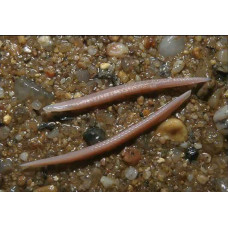A subtype of chordate. The vertebral column is not isolated. The axial skeleton is chordate. The skull is absent. The body is segmented, including the nephridial and genital systems. There is an atrial cavity. Sensory organs and brain are primitive. Heart absent. Small marine animals. Occupies coastal waters of the Atlantic and Pacific Oceans. Class 1 - Lancetidae (Leptocardii).
The absence of a skull, brain and heart and the colourless blood distinguish the lanceolates not only from fish but from all vertebrates, among which they occupy the lowest position. The difference between the lanceolates and other vertebrates is so great that some scientists consider the craneless group to be a separate class, contrasting them with all other vertebrates that have a skull (Craniota). The Lanceolus, which Pallas, who first described it, thought was a snail and called it Limax lanceolatus, is a small, semi-transparent animal up to 40mm long, with a general body shape similar to that of a fish. It is found on the sandy shores of the German and Mediterranean Seas and in South America. The lanceolators found in other seas and described as separate species are probably also A. lanceolatus. The lanceolatus usually lives buried in the sand, but can swim well if disturbed.
Craneless animals are among the most primitive chordates. They live exclusively in the sea. Unlike other chordates - bivalves and vertebrates - cranians retain the main features of the type (chorda, neural tube and gill slits) throughout their lives. The head is not separated, the neural tube is not divided into brain and spinal cord, and the skull is absent (hence the name). Only about 30 species are craneless.
The craneless animals are exclusively marine and widely distributed in shelf waters. They are mostly sedentary. They protect themselves by sinking into the sand with the front part of their body. The body is small, 5-8 cm long, fish-like, metamerous, thin and translucent. It has no head and consists of a body and a tail. The paired limbs are absent, replaced by medial fins. There is no external skeleton. The axial skeleton is a tendon - elastic, dense and flexible rod. Epidermis monolayer. There are dorsolateral muscles segmented as myotomes. The integument is enterocelic, reduced in the pharyngeal region - an atrial cavity is developed there. The chord is constant, bacilliform, and extends from the head to the tail.
Feeding in the gut is largely passive. The digestive tract is continuous and the pharynx is wide with numerous permanent gill slits. Feeding is by filtration. The intestines are straight and not divided into sections. Breathing occurs simultaneously with feeding, with gas exchange taking place in the vessels between the gill membranes. The circulatory system is closed, relatively primitive and consists of arterial and venous vessels; unlike vertebrates, they have no heart. Respiratory pigments such as haemoglobin are absent. There is a portal vein system in the hepatic outgrowth. Excretion is by numerous (up to 90 pairs) nephridia located in the pharyngeal region. There is a dorsal nerve tract in the form of a tube, without ganglia or brain. The dorsal and ventral nerve roots are not connected.
Individuals are differentiated by sex. The sexual gonads are numerous and metamerically repeated. There are no excretory ducts. No asexual reproduction. Fertilisation is external, in sea water.
Little is known about the ancestors of modern glandless animals, as they are poorly preserved due to the lack of bony or cartilaginous parts. It is likely that the ancestors of the glandless were free-floating, had no atrial cavity and their chordae did not reach the head end of the body. This group gave rise to two branches: one retained the free-floating lifestyle and led to vertebrates, and the other adopted a sedentary or swarming lifestyle and led to craneless animals. Another view is that the lanceolates were neotenic forms of pre-existing bottom-dwelling animals that adapted to reproduce in the larval stage. The earliest known craneless animal is Pikaia.
The craneless species include a modern class of lanceolates (Leptocardii), represented by a family of lanceolates (Branchiostomidae) and three genera. In total, the subtype comprises about 30 modern species.
Craniumless (Acrama)
Tags: Craniumless (Acrama)


